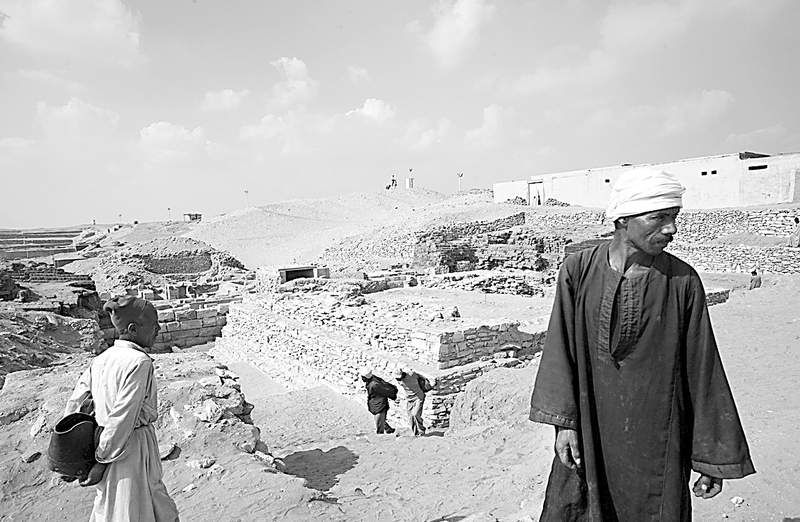In Egypt, is it just one more old pyramid?
Published 4:00 am Monday, November 17, 2008

- Workers continue excavation near the base of a newly discovered pyramid in Cairo. Its base can be seen at the center of the photo.
CAIRO, Egypt — Deep below the Egyptian desert, archaeologists have found evidence of yet another pyramid, this one constructed 4,300 years ago to store the remains of a pharaoh’s mother. That makes 138 pyramids discovered here so far.
Tourists will, no doubt, care.
Egyptians probably will not, unless they work in tourism.
The pyramids are proof of Egypt’s endurance and what distinguishes it from modern confections, like Saudi Arabia, a nation founded 76 years ago, named after a family and built on oil wealth. But these monuments to Egypt’s early ingenuity are also an ever-present symbol of faded glory. It is hard to escape comparisons between an Egypt that once led the world in almost everything and modern Egypt, where about 40 percent of the population lives on $2 a day.
“Can you believe our government can do nothing for us, and this thing that was built thousands of years ago is still helping me feed my family?” Ahmed Sayed Baghali, 49, said as he sat in a plastic chair selling postcards to tourists outside the Egyptian Museum here, which displays millenniums of antiquities. “Who would buy my things if they were not about the pharaohs? People come here from very far to see the pyramids, not to see Cairo.”
Baghali’s Cairo is a city of about 18 million people that is layered with history stretching back to the birth of civilization. The ubiquitous nature of antiquities — stick a shovel in the ground almost anywhere and it is difficult not to find something — has helped mold a collective consciousness, a national identity, that is uniquely Egyptian.
“A man without history is a man without humor,” said Galal Amin, an economist and author who has written about Egypt’s modern decline. “A man with history is more likely to have humor, because he is more likely to see the irony in things, how things were and how they turned out to be. And patience.”
Egyptians, as a group, are extremely patient, though given the growing pressure of daily life, a bit less than they used to be. Their it-is-what-it-is attitude is often attributed to a strong religious faith and a conviction that all events are God’s will.
Yet growing up and living amid so much history has something to do with that view, too; the abundant antiquities in everyday life are a constant reminder of one’s place in time.
People come and go, pharaohs come and go, even President Hosni Mubarak, who has ruled Egypt for 27 years, will go, too (though talk of that certainty is discouraged).
No need to worry.
Or as Egyptians like to say, “Maalesh,” which, depending on the circumstance, means “Never mind” or “Oh, well.”
“When other people talk about hoping to see something happen soon, they probably mean within the next few months,” said Aly Salem, an Egyptian playwright. “For an Egyptian, it could mean in the next 50 or 60 years. An Egyptian has a particular pace. His pace is different than an American’s. And a long history can do this.”
Little to brag about
These days, Egypt is rarely spoken of in a positive context. The education system is in crisis, and unemployment, traffic and pollution are all major problems. Top to bottom, the state seems to have seized up.
When the historic parliament building burned recently, firefighters bungled for hours before bringing the blaze under control.
When a rockslide crushed a neighborhood, the authorities responded slowly, infuriating rather than rescuing.
The most recent proof that Egypt’s contemporary troubles amount to a blip in its long history, the 138th pyramid, was unearthed in a vacant patch of sand. The discovery, announced last week, was made not far from Sakkara, the step pyramid that, at 5,000 years old, is the oldest known pyramid in Egypt.
Twenty years ago, Zahi Hawass, now Egypt’s chief of antiquities, began excavating the area around Sakkara, which is in Giza, part of Greater Cairo. Remains of the newest pyramid were found about two months ago, 23 feet beneath the surface of the desert.
Hawass said it appeared that the pyramid was built for Queen Sesheshet, the mother of Pharaoh Teti, the first pharaoh of the Sixth Dynasty, who ruled from about 2345 to 2333 B.C. Little remains of what is believed to have been a 45-foot-tall pyramid.
One day last week, Abdel Hakim Karar, director of the excavation, escorted visitors into the pit. “In this small space, you see about 2,000 years of history,” he said, with pride and a sweep of his hand.
Karar watched as a group of poor Egyptians, peasant farmers from a nearby village, slowly, very slowly, hauled satchels of sand and rock on their backs out of the pit. “They don’t know how to work,” he complained.
The men, mostly barefoot, said they were paid 13 Egyptian pounds a day, a bit more than $2, to haul the debris — and were glad to have the work. The pyramids, they could take them or leave them.
“We feel the might of this history when we get paid,” said Sayyid Saber Shabaan, 21, when he stopped to take a 10-minute break. “But if we don’t get paid, we feel nothing. We are used to these things. We are always here.”






